Cooking For Your Dogs
Dr. Judy Morgan, Yin & Yang Nutrition For Dogs
 In a world where we barely have time to prepare our own meals, Dr. Judy Morgan says we should be cooking for our pets. The store bought pet foods contain diseased and euthanized animals as well as high levels of heavy metals. She gives us some timesaving tips to create your own pet food.
In a world where we barely have time to prepare our own meals, Dr. Judy Morgan says we should be cooking for our pets. The store bought pet foods contain diseased and euthanized animals as well as high levels of heavy metals. She gives us some timesaving tips to create your own pet food.
Holistic Veterinarian Dr. Judy Morgan has a book called, "Yin & Yang Nutrition For Dogs: Maximizing Health With Whole Foods, Not Drugs." Dr. Morgan is an integrative veterinarian. She practiced traditional medicine for many years before she became alternative. Now, she incorporates traditional medicine along with traditional Chinese veterinarian medicine, chiropractic, acupuncture, herbal therapy, and her favorite of all, food therapy.
What is food therapy? Food therapy uses food to get an animal through something instead of drugs. In about 80-percent of the cases that Dr. Morgan sees, she is able to either minimize their drugs or completely get them off medications just with diet changes and adding herbs. She tells us that herbs are just another form of food and food has amazing powers for healing, which has been often overlooked.
Dr. Morgan tells us there are so many things in commercial pet foods that we should be concerned about. Just a couple of weeks ago the FDA came out with a statement that said, "Pentobarbital in pet food, which is euthanasia solution, may be a bigger problem than they really realized." This is surprising, since we've known that pentobarbital has shown up in our pet foods since the 1990's.
The reason this occurs is because FDA does not enforce their own law that states only animals that have died by slaughter can be used for pet food. And so they are allowing animals that died out in the field, animals that were euthanized, or any sort of carcass to be used in pet food and they won't enforce their own laws. So we know that there are euthanized animals being found in pet food.
A few years ago when there was a huge problem with one brand that killed some dogs, they found it was pentobarbital and they also found horse meat DNA in a product that was labeled as beef. So we know that a lot of the foods out there or adulterated. While pentobarbital is just one of the things, heavy metals are another huge issue, s well as poor quality ingredients. Many waste foods from the human food industry are going into pet food. So recycled oils, brewers distilled grains, basically a lot of fillers that are waste products for the human industry go into pet food. Dr. Morgan doesn't personally think that her pets should be the landfill.
So are you doing the right thing by buying premium food? You would be surprised that a lot of foods, both cheap and premium, are really sourced from the same places. So the food that had the pentobarbital and killed dogs as well as the food containing horse meat, listed on their website that their food was all human grade sourced from USDA meat. Bottom line, you can't trust the websites.
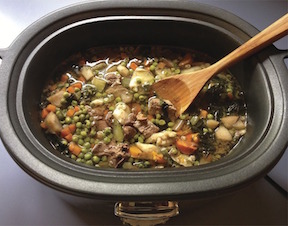 A new issue that we're having right now, according to Dr. Morgan, is that everybody thinks that grain free is better. Unfortunately, we are seeing dogs that are succumbing to dilated cardiomyopathy, which has been traced back to a problem with taurine deficiency in these diets. And even if the diet is not deficient for some reason, the legumes and potatoes are blocking the absorption and utilization of the taurine. So we have dogs going into heart failure and the owners are saying, "Oh, I feed that really expensive, grain-free kibble. It's supposed to be so good for my dog," except that it's not!
A new issue that we're having right now, according to Dr. Morgan, is that everybody thinks that grain free is better. Unfortunately, we are seeing dogs that are succumbing to dilated cardiomyopathy, which has been traced back to a problem with taurine deficiency in these diets. And even if the diet is not deficient for some reason, the legumes and potatoes are blocking the absorption and utilization of the taurine. So we have dogs going into heart failure and the owners are saying, "Oh, I feed that really expensive, grain-free kibble. It's supposed to be so good for my dog," except that it's not!
Are any commercial pet foods good for our pets? There are some. However, Dr. Morgan has not seen a kibble that she can endorse. She is a raw feeder for her own dogs. She either feeds raw or home cooked and makes a lot of her own foods.
There are a very select few companies that she knows the owners personally. She's gone to their plants and has seen where they source their meats. There are a couple that she trusts, but not many. She tells us that Answers Pet Food is phenomenal. Two sisters own the company and they're located in Lancaster, Pennsylvania. It's a raw food company. They ferment all their products so that they don't have to ever worry about bacterial contamination. Their probiotic and good bacteria load is so high. Another small raw food company that she adores is Allprovide out of Atlanta, Georgia. These are two companies that make canned food, and again, while she says that there are no kibble food companies that she can endorse, she could, if push came to shove, feed Carna4, because she knows the owner of that company and knows what they're doing.
There have been a lot of owners who ran small companies and were making really good food on a small-scale basis and shipping it across the country. However, when they get real popular, the big companies buy them out and all of a sudden their food goes down the tube.
Commercial pet food runs from cheap to expensive and making food for your pet isn't as expensive as you think. As an experiment, Dr. Morgan did a video in the grocery store. She did a comparison of buying fresh whole foods to make a stew for her dogs versus what was available on the grocery store shelves. She was able to get enough whole foods to make about a 12-pound crockpot stew for her pets. This was less per pound than everything on the shelf, except for the really bottom of the barrel stuff. This turned out to be a lot cheaper than the grocery store stuff, which we know is cheaper than what you're getting in the pet stores.
Dr. Morgan looked at the clock when she started chopping everything up and throwing it in the pot. It took her 30 minutes. She had to go to the grocery store anyway, so it took her just 30 minutes to prep enough food for 12 pounds of food. She has eight dogs in her house, so it's not going to last her that long. But for somebody who had one dog or a couple of dogs, that could last you quite a while.
When Dr. Morgan grinds raw food for her pets, and she goes through about 270 pounds of food per month for her dogs, she gets in the zone. She will stand there and grind for an hour to two hours and can grind a 120 pounds of food during that time. For her, it's like a Sunday afternoon of work and her pets are worth that because he then knows what they're eating.
 So how can you make sure you are providing a complete and balanced diet if you make you own pet food? If you buy meat and vegetables, do you need to add any supplements? Dr. Morgan says yes, there are things that we need to add in. A couple of the biggest things that most people aren't aware of is that our animals have a higher calcium requirement and they have to have more calcium than phosphorous. Meat is higher in phosphorous, so it's the wrong ratio. So we do need to add a calcium supplement, which is very simple to do. If you're feeding raw food, then just grind up the bone and include that in there. You can also grind up eggshells and use those or you can buy a commercial vitamin mineral supplement that is made specifically for homemade pet diets. You don't want to use just a generic like One-A-Day type vitamin. For pets, it needs to be specifically made for homemade cooking. So there are a couple brands on the market. One is Rx Vitamins, which makes Canine Minerals as well as Feline Minerals. Dr. Tobias also makes one called GreenMin, which provides all of the minerals you will need to add.
So how can you make sure you are providing a complete and balanced diet if you make you own pet food? If you buy meat and vegetables, do you need to add any supplements? Dr. Morgan says yes, there are things that we need to add in. A couple of the biggest things that most people aren't aware of is that our animals have a higher calcium requirement and they have to have more calcium than phosphorous. Meat is higher in phosphorous, so it's the wrong ratio. So we do need to add a calcium supplement, which is very simple to do. If you're feeding raw food, then just grind up the bone and include that in there. You can also grind up eggshells and use those or you can buy a commercial vitamin mineral supplement that is made specifically for homemade pet diets. You don't want to use just a generic like One-A-Day type vitamin. For pets, it needs to be specifically made for homemade cooking. So there are a couple brands on the market. One is Rx Vitamins, which makes Canine Minerals as well as Feline Minerals. Dr. Tobias also makes one called GreenMin, which provides all of the minerals you will need to add.
Another thing that Dr. Morgan finds low in homemade pet food is vitamin D. We get vitamin D from egg yolks and from fish. So if you're including egg yolks or fish in your pet's diet, you're going to be fine. If not, then you need to get a vitamin D supplement. A 20-pound dog only needs 100 units of Vitamin D. Most supplements that you will find over the counter are around 2,000, 5,000 and even 10,000. So you may have to get an animal specific vitamin D to get a low enough dose.
So if you make your own pet food, there are only two supplements that you might need to add. Dr. Morgan tells us that she is now to the point where she can do her pets' diets without even needing the supplements, as she knows what she needs to put in there.
 The reasons why Dr. Morgan wrote her book, Yin & Yang Nutrition For Dogs, is so that people can make their own pet food. The book contains about 60 recipes and it also has a chapter on what you need to do to get the diet balanced.
The reasons why Dr. Morgan wrote her book, Yin & Yang Nutrition For Dogs, is so that people can make their own pet food. The book contains about 60 recipes and it also has a chapter on what you need to do to get the diet balanced.
Visit Website
True or Poo?
Nick Caruso
 From the author of Does It Fart? Nick Caruso has another book called, “True or Poo? The Definitive Field Guide to Filthy Animal Facts and Falsehoods.’ This interview is not for the faint hearted. You'll find out just how many spiders you eat in your sleep, if beaver butt is an ingredient in vanilla ice cream and which animal may die from constipation.
From the author of Does It Fart? Nick Caruso has another book called, “True or Poo? The Definitive Field Guide to Filthy Animal Facts and Falsehoods.’ This interview is not for the faint hearted. You'll find out just how many spiders you eat in your sleep, if beaver butt is an ingredient in vanilla ice cream and which animal may die from constipation.
So what is the filthiest fact in the book? Nick explains it all depends on your comfort level. But what he's heard from some people, the one that tends to get people the most, is that there are mites on everyone's face right now. Microscopic mites are living in and near your pores, which tends to get people a little squeamish.
What about eating a lot of spiders when we sleep, is this true? Good thing Nick says that is poo! However, he then goes on to say that you've probably eaten more spiders in your food! Fortunately it's not that many; maybe a couple in your lifetime, but it's not a regular occurrence, which makes sense. People are big and loud and spiders don't tend to want to go near our mouths.
So is it true that drink flavors and ice cream flavors are made from ingredients from a beaver's butt? Nick tells us this can be true but it's probably not because it's so expensive to milk their glands to extract. So it's more of a delicacy. So does it taste good? Nick says he actually doesn't know. He assumes he's eaten it like everyone else at some point and said it tastes like vanilla, just like it smells.
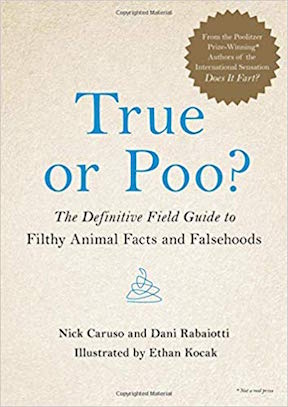 So far it's all been poo, so what are some truths? Some fascinating facts, according to Nick, is a species of a tree shrew, a mammal, that will poop inside of a pitcher plant and that's how it the plant gets its nitrogen. The tree shrew will defecate into pitcher plants, which normally people associate those with trapping insects, to gain nutrients. But they actually gain their nitrogen and other nutrients through digesting the feces of the tree shrew.
So far it's all been poo, so what are some truths? Some fascinating facts, according to Nick, is a species of a tree shrew, a mammal, that will poop inside of a pitcher plant and that's how it the plant gets its nitrogen. The tree shrew will defecate into pitcher plants, which normally people associate those with trapping insects, to gain nutrients. But they actually gain their nitrogen and other nutrients through digesting the feces of the tree shrew.
Dr. Debbie thinks that maybe the tree shrew is getting special service or maybe it's like a bidet for the shrew. After they've done their business, then maybe they're getting something else out of it and that is why they've chosen that spot. Or, maybe it's very reclusive and hides them so they feel like they have privacy, and who doesn't like little privacy when they go to! Nick explains that they do get a little extra something. They're able to eat the nectar while they're going. So it's kind of a bathroom and food break all at once.
Next, Nick tells us if it is true or poo that when a scorpion sheds its tail, it dies of constipation. That is true! He says we normally think of animals that can shed their tails like lizards and salamanders, which they can regrow back and it's no problem. This is because their cloaca, where they defecate, isn't located on their tail. However, for scorpions, their anus is actually on their tails. So if they lose their tail, they lose the ability to go number two. It just keeps building up and building up and then they die. It's a defense mechanism, just like lizards, so they can escape a predator. While it doesn't do any good to escape a predator if they're going to die anyway, it does give them a little bit longer. They can survive surprisingly long without their tails and not being able to go to the bathroom. This gives them a few more opportunities to hopefully mate and give them something to live for.
 The answers to all of these questions and more can be found in True or Poo?, a manual for disgusting and one-upping your friends and enemies for years to come.
The answers to all of these questions and more can be found in True or Poo?, a manual for disgusting and one-upping your friends and enemies for years to come.
Visit Website
How To Build The Perfect Litter Box - Dr. Debbie
 One sniff upon entering your home and you recognize the unmistakable odor of cat urine and feces. Simba has used your entry hall as his litter box again. But before you lose your temper - stop. By scrutinizing the environment through your cat's eyes, you will likely discover the cause of his toileting mishaps.
One sniff upon entering your home and you recognize the unmistakable odor of cat urine and feces. Simba has used your entry hall as his litter box again. But before you lose your temper - stop. By scrutinizing the environment through your cat's eyes, you will likely discover the cause of his toileting mishaps.
Elimination issues are a main reason for veterinary visits and a primary reason for relinquishment of cats at shelters. House soiling problems can be multi-factorial, with an overlap of behavioral, environmental and medical causes. Feline house soiling can be managed however with sleuth work and patience. The challenge is to think like a cat.
First and foremost, say this and repeat it…"My cat does not eliminate out of the litter box to get even with me." Cats do use urine and fecal scent marks to communicate territory, but this isn't done with spite or in effort to "get even" with you. Inappropriate elimination is a cat's way stating that something isn't right in their world. Understanding this is key before tackling feline house soiling. Focus on what's wrong in Simba's toilet area, not on how the house soiling makes you feel.
Start With a Vet Check
Cat owners often struggle with house soiling mishaps for months or years before enlisting help from their veterinarian. But seeing the veterinarian should be the first step, since health disorders may be at the root of some house soiling issues. Your efforts in restoring litter box usage will be doomed if an underlying medical cause is not addressed at the same time.
Size Does Matter
Make sure your cat's litter box is of adequate size to allow maneuvering. Litter box size should be 1 ½ times the length of cat's body length. Height of the edge also matters. For older kitties, try lower profile litter boxes or plastic under bed storage boxes. An arthritic older cat won't complain or cry in pain with arthritis, she'll just chose to eliminate elsewhere.
Consider the View
Cats don't want to be startled while in the loo. Don't place the litter box in a high traffic area where people and pets are always a-coming and going. Cats prefer a low traffic area where they can have an eye out on things.
Don't place the litter box near appliances which give off noise, vibration and heat, all which disturb your cat while eliminating. Once a negative aversion is created, your cat may not return to use that box in the future.
Ditch the Litter Box Cover
While some nervous kitties prefer the privacy of litter box covers, the majority of cats dislike the tight quarters and limited ventilation litter box covers provide. Consider how you feel in a public porta-potty. Do you like to touch the walls when inside? Sure, people like the way the lid contains odors, but does it really matter how little odor comes from the litter box when your cat is pooping on your oriental rug?
Provide More Than One Box
A common error is assuming that one litter box is all your cat needs. What cat owner loves the litter box, and relishes seeing more of them in the home? But the more the better when it comes to faithful litter box usage, especially with multiple cats. The general rule is to provide one more box than the number of cats. Some cats share litter boxes, others will not. Unless you provide alternate sites you may have elimination issues in multiple cat homes.
 Another special consideration is differences in cat's personalities - timid cats may avoid crossing paths with other more assertive pets in home. Be sure to provide litter box sites that won't be blocked by other animal's movements.
Another special consideration is differences in cat's personalities - timid cats may avoid crossing paths with other more assertive pets in home. Be sure to provide litter box sites that won't be blocked by other animal's movements.
If you live in a multilevel home - you must provide litter box sites on each level. This is especially important in multi-cat homes, those with senior cats or those with health conditions.
The Pick of Litters
Litter texture preferences vary and there are many choices from scoopable, clay, crystals, or natural litters. However in one research study of cat's litter box habits, it demonstrated that the majority of cats prefer fine grained scoopable clay based litters that have carbon as their odor absorbing ingredient. Every cat is different though, so try other litter varieties until you find your cat's preference.
Skip the Scents
The verdict is still out on what odors cats prefer, but avoid heavily scented litters or deodorizers if your cat is missing the box. Interestingly enough, one study showed cats preferred cedar and fish odors, while avoiding citrus and floral scents, while another study concluded cats preferred fish or bleach smells to other scents.
Kitty Litter Depth
Ideal litter depth is 2 inches - more isn't always better. Some cats thrive on scratching the bottom of the pan, which is obscured by excessive amounts of litter.
Keep It Clean
Cats are fastidious by nature and will avoid using a soiled or smelly box. The overall cleaning frequency depends on the number of cats in the home. General advice is to scoop twice a day and deep clean the litter pan weekly. Change out clumping litter every 2-3 weeks.
Build It and Kitty Will Use It
By building your cat's dream litter box, your cat will find litter box nirvana. And you'll come to enjoy a better relationship with your kitty family members without those unwanted "presents" in the foyer.
Featured veterinarian known as "Dr. Debbie" on national pet radio program, Animal Radio. Ebook author of "Yorkshire Terriers: How to Be Your Dog's Best Friend"; "Pugs: How to Be Your Dog's Best Friend"; "Mini Schnauzers: How to Be Your Dog's Best Friend"; and "Shih Tzu: How to Be Your Dog's Best Friend." Dr. Debbie's books.
Visit Website
Animal Radio News - Lori Brooks
 Pet Food Companies Want To Stop Studies That Analyze Their Foods
Pet Food Companies Want To Stop Studies That Analyze Their Foods
Researchers at the University of Nevada in Reno have been pondering the question, "What is really in the food our pets eat?" So they started looking for answers. The results of their first study are worrisome. In the first 100 samples they analyzed, 16 of those samples had mercury concentrations that were well above the maximum tolerable limit. Most of those high mercury levels were found in fish-based cat foods, mainly tuna cat food, but the high mercury levels also showed up in products with salmon, white fish and shrimp. And it's not only cat food. They found high mercury levels in dog food too. These included both wet and dry foods. Genetic testing in some samples casts further doubt on pet food labeling. A well known, common brand of pet food labeled 'Duck and Potato,' was found to contain sheep, which was not listed on the ingredients label. As you can imagine, no pet food company wants this study to continue, so the researchers are turning to the potential source with the biggest stake in finding the answers - to the pet owning public - through crowd sourcing. You can learn more and follow their research on their Facebook page. In the meantime, their best advice is to feed your pet a variety or foods and cut down, if you can, on fish-based formulas, especially tuna.
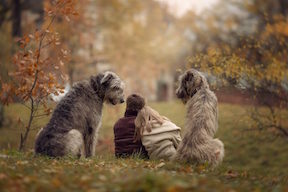 Dogs Owners Get More Satisfaction From Large Dogs
Dogs Owners Get More Satisfaction From Large Dogs
According to an international survey from RightPet, dog owners say they get more satisfaction from owning large dogs than small dogs. That is especially true for men and young people. The study surveyed dog breed reviews from more than 12,000 pet parents from 106 countries. The survey also found that both women and men are happier owning large dogs than small dogs; men and younger people are significantly more satisfied with larger breeds and less satisfied with toy and small dogs; older people (around age 70) are equally satisfied with any dog size; and dog owners with experience owning multiple dogs of different sizes report the greatest satisfaction with large dogs. Why are dog owners happier with large dogs than small dogs? The RightPet study found a direct correlation between dog size satisfaction and the fact that dog owners rate bigger dogs as more emotionally stable, child-safe, trainable and less-barky than small dogs.
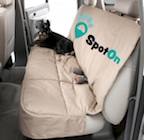 SpotOn Car Service for Pets
SpotOn Car Service for Pets
The number of unique new services created for pets and their humans continues to soar. In New York, there's a pet-friendly car service that caters to pet parents who are otherwise regularly turned down by standard taxis or other car services. It is a godsend for pet parents who can't fit their 60-pound dog into a bag to ride the NYC subway. The new service is called SpotOn. All you have to do is go to the SpotOn website or use their app to schedule a pick up one hour ahead of the time it's needed. Each car is wiped down with antibacterial wipes in-between rides. The cars include pet amenities such as water, antibacterial wipes, lint rollers, backseat covers, crash tested carriers and treats for dogs and cats. SpotOn will take any size dog, cat or small pet. In addition, their drivers are trained in pet first-aid and CPR certified. They can also transport your pet to appointments when you are too busy to go with them. Luckily for everyone, the company has plans to expand to all major US cities.
Judges Decide Who Gets The Pets
There's a law in California granting judges the authority to settle disagreements over who keeps the family pet in divorce cases. Those cases are now being handled the same way judges handle child-custody disputes. Previously, Fido and Kitty have been considered family property, a status giving them little more standing in a divorce than a family's big-screen TV or a refrigerator. This means the judge deciding who gets to keep the pet will have the discretion of weighing such factors as who feeds them, who takes them to the vet and on walks and who protects them. In the past, many judges would put the animal in the middle between the owners and try to determine which pet parent the pet liked the best. The new law went into effect on January 1, 2019.
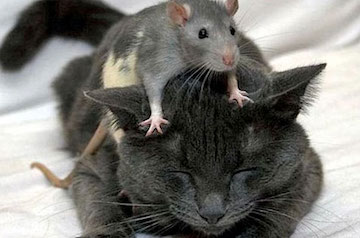 Cats Are Overrated As Rat Predators
Cats Are Overrated As Rat Predators
In a first-of-its-kind study, scientists tracked interactions between feral cats and local rat populations. Using microchips to track the movements of rodent populations, scientists found that rats are adept at avoiding cats. Over the course of 79-day study, scientists recorded only two cat-caused rat deaths. Their findings, published in the journal Frontiers in Ecology and Evolution, confirmed their suspicions that the presence of cats doesn't actually shrink rat populations, but may make them less visible. The study explains that, "People see fewer rats and assume it's because the cats have killed them, whereas it's actually due to the rats changing their behavior, hiding in better places or staying in their burrows longer." Furthermore, the results of the study suggest the benefits of releasing cats are far outweighed by the risks to smaller wildlife such as birds.
 Listen to the entire Podcast of this show (#1112)
Listen to the entire Podcast of this show (#1112)





